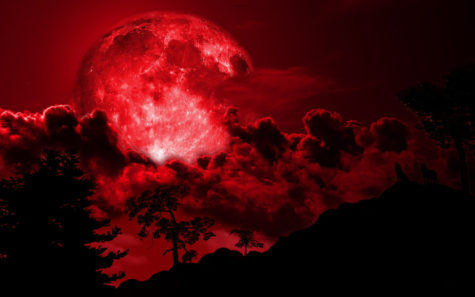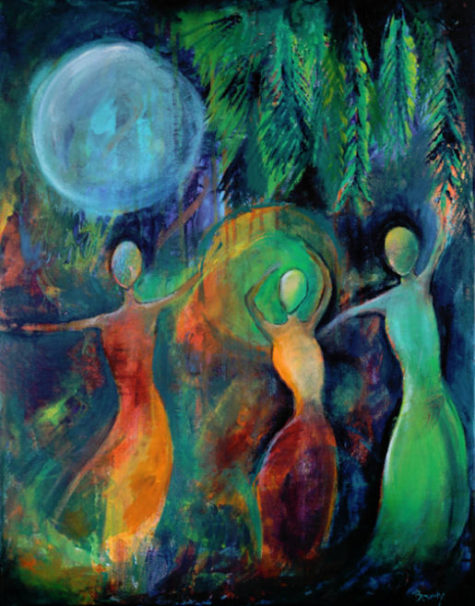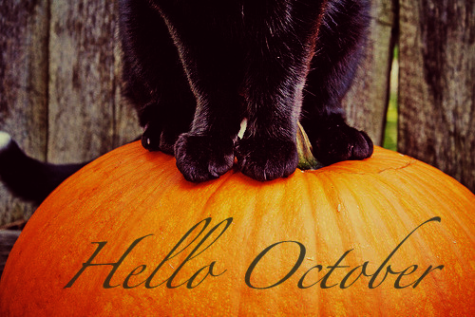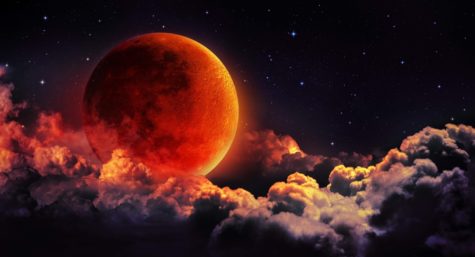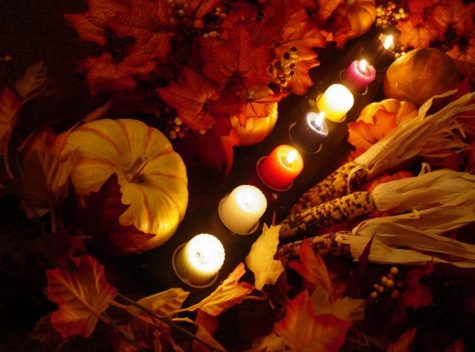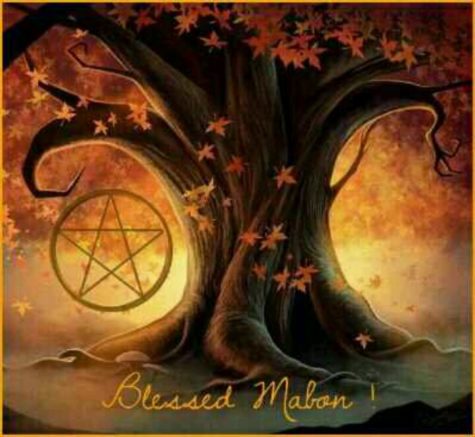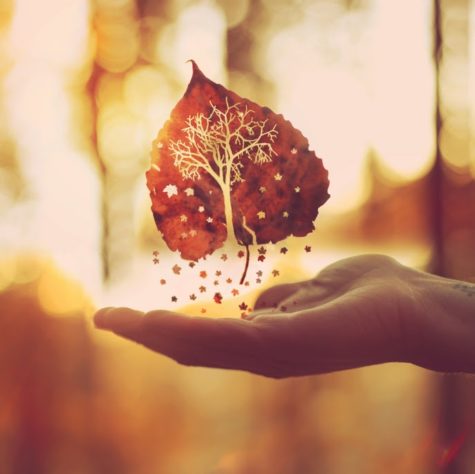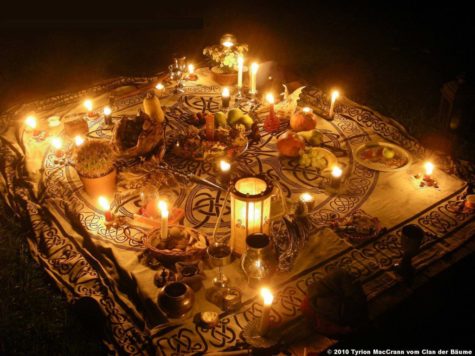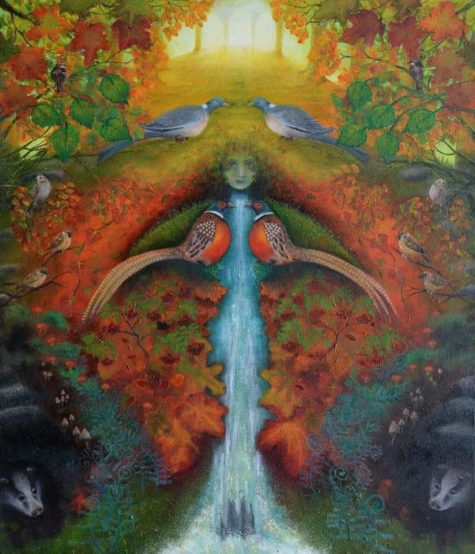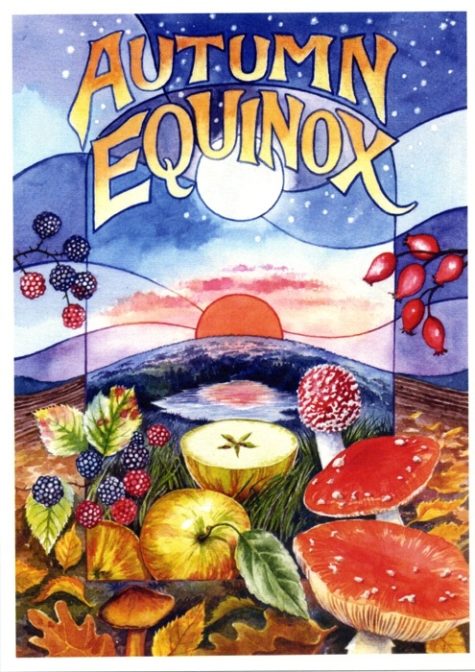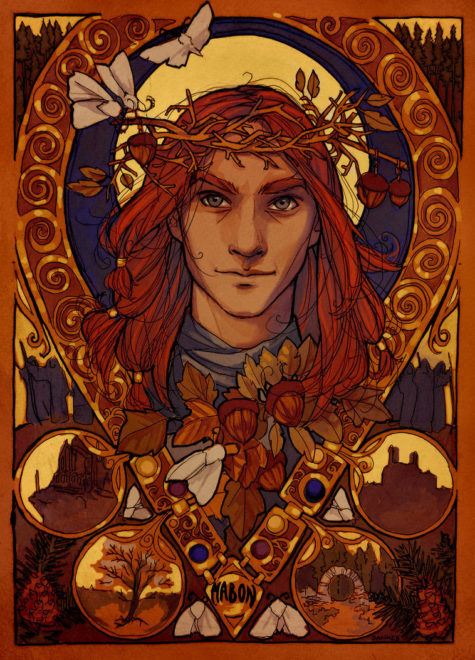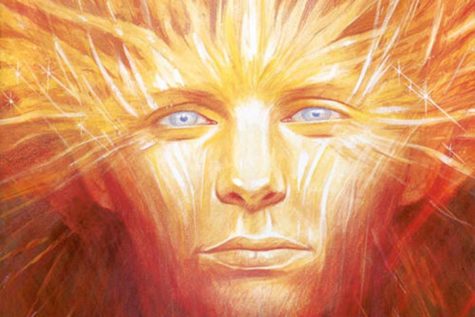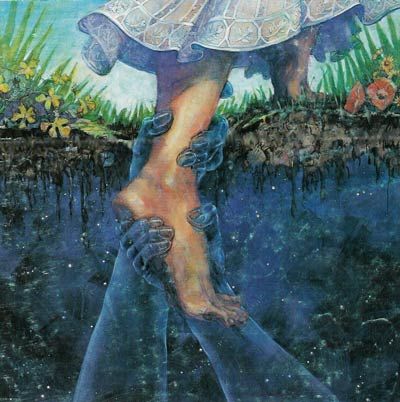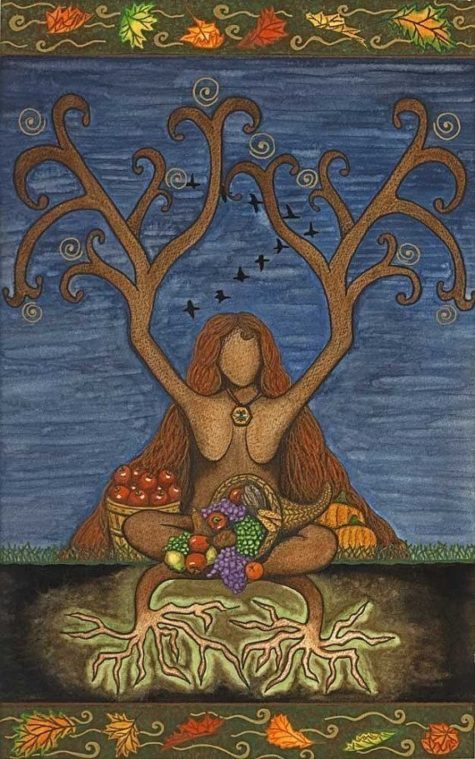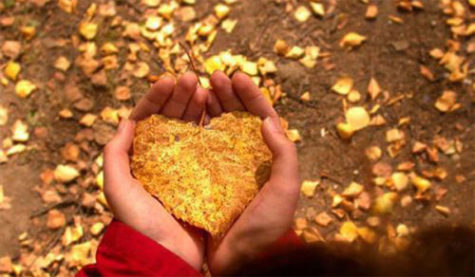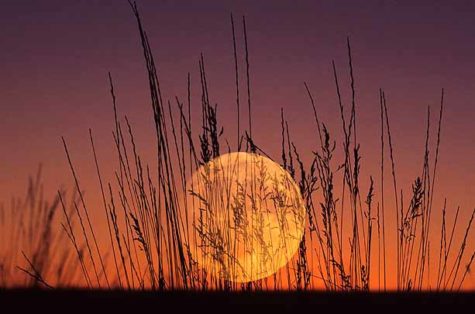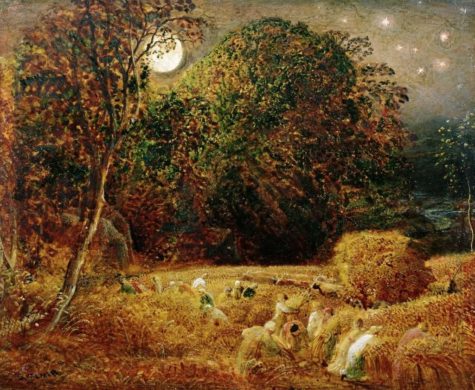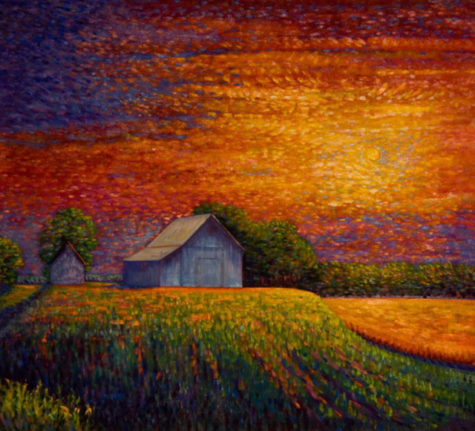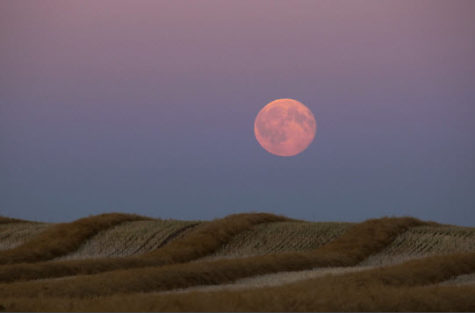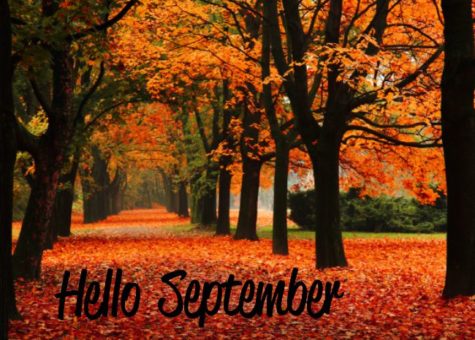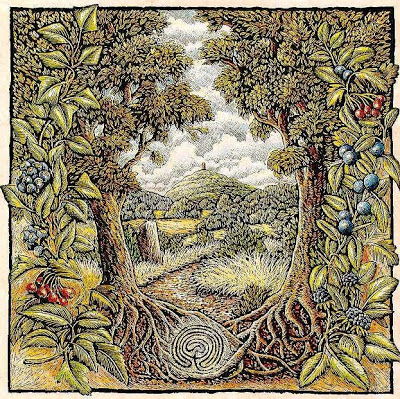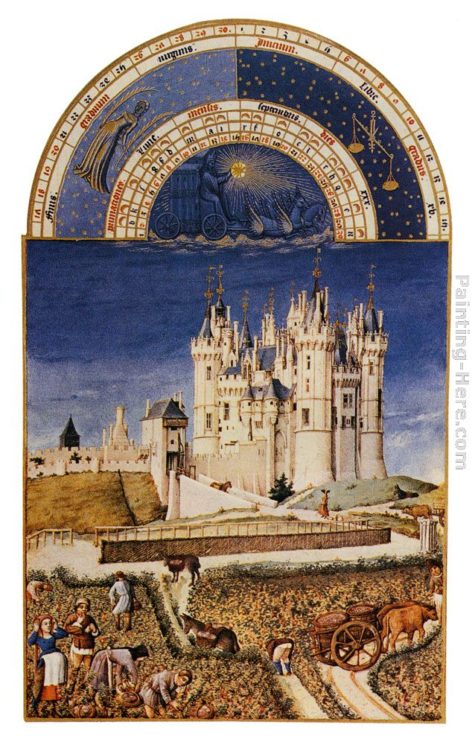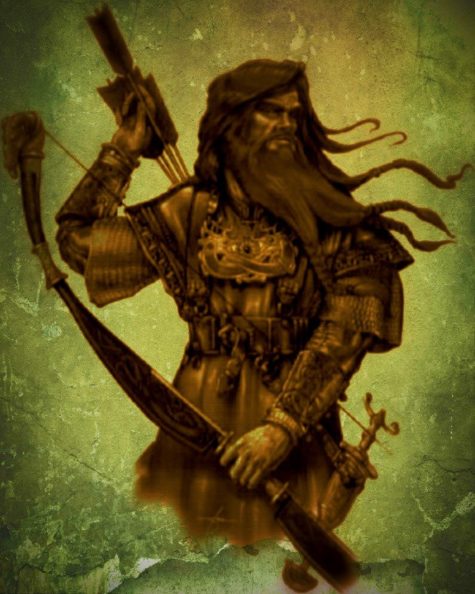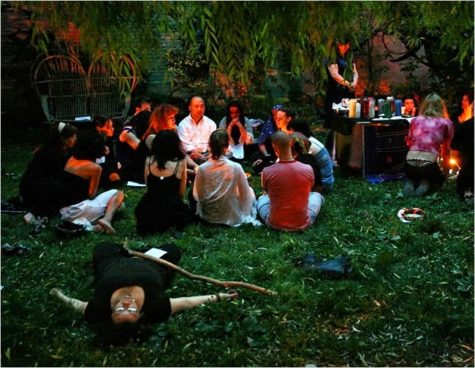Autumn
October’s full moon is often referred to as the Blood Moon, or Sanguine Moon. The Blood Moon takes its name not from blood sacrifices, but from the old custom of killing and salting down livestock before the Winter months made it impossible to feed them. Only the choicest stock was kept through the cold season.
The leaves are falling from trees, the deer are fattened, and it’s time to begin storing up meat for the long winter ahead. Because the fields were traditionally reaped in late September or early October, hunters could easily see fox and other animals that come out to glean from the fallen grains.
Coming right before Samhain, it’s a time when the nights are crisp and clear, and you can sense a change in the energy around you.
Correspondences:
- Colors: Dark blue, black, purples, Deep Blue Green
- Element: Air
- Scents: strawberry, apple blossom, and cherry
- Gemstones: Obsidian, amethyst, tourmaline, opal, beryl, turquoise
- Herbs: Apple blossom, pennyroyal, mint family, catnip, Sweet Annie, thyme, catnip, uva ursi, angelica, burdock
- Flowers: Calendula, marigold, cosmos
- Trees: Apples, yew, cypress, acacia
- Birds: Heron, crow, and robin
- Animals: Stag, jackal, elephant, ram, scorpion
- Nature Spirits: Frost and plant faeries
- Gods: Herne, Apollo, Cernunnos, Mercury, Ishtar, Astarte, Demeter, Kore, Lakshmi, The Horned God, Belili, Hathor
- Powers/Advice: A time to work on inner cleansing, letting go karma, reincarnation, justice and balance.
This is the time when the veil between our world and the spirit world are at its thinnest. Use this time for spiritual growth — if there’s a deceased ancestor you wish to contact, this is a great month to do it. Hold a séance, work on your divination, and pay attention to messages you get in your dreams.
Probably because of the threat of winter looming close, the Blood Moon is generally accorded with special honor, historically serving as an important feast day in both Western Europe and among many Native American tribes.
The Blood moon focuses around connecting with animals, and our animal totems and guides. Those who practice looking at the degrees of the lunar cycle may realize that this is the last time the moon will be at a later degree. This conjunction will allow many to look at life differently every time the new moon approaches and allowing us to look at past and the future at the same time.
This moon also forces us to look at love completely differently and ask the questions:
- What is love?
- Is the love you have unconditional?
That love does not have to be just in the areas of relationship but also our interaction with people, it can even be love of work and things you have acquired.
Additionally it means to be able to let it go of someone or something no matter how much you love it because it needs to be set free. The past years have reminded us that changes need to happen that this kind of life is no longer tolerant and peaceful. We will be reminded once again we can no longer walk in other people’s shadows.
Because this moon focuses around our animal nature, some of us may become very aggressive in what we say or do. It may cause many people to act out. This type of moon has been known for violence, suicides and domestic disputes over things that may or not exist – another reason it is known as the blood moon.
A Ritual For The Blood Moon
Here’s a nice little ritual to do for the Blood Moon.
You will need:
- A special glass or chalice – something pretty
- Rose water – or spring water
- White cotton cloth
- Red wine
- Ripe pomegranate
- Honey
- Silver spoon
For this ritual it will be nice to dress up a little. Wear white or silver, and if you have it, silver jewelry with carnelian, or moonstone. Use a special glass or chalice.
Rinse the chalice with rose water and dry it with a clean white cotton cloth. Pour the cup of red wine into the chalice, slice the pomegranate in half and squeeze the juice into the wine. Add a teaspoon of honey, and stir with the silver spoon.
Go outside. If you are doing this with friends, form a circle. Lift the chalice in the direction of the moon and say a few words of praise, thanks, appreciation, whatever feels appropriate and right. Then take a sip of the wine and pass the chalice clockwise around the circle (if there is one). Each person “toasts” the Blood Moon and drinks.
When the circle is complete, pour the rest of the wine on the ground as a “libation” or offering to the earth.
Collected from various sources including: PaganWiccan.About.Com, Art by Beverly Ash Gilbert.
In the ancient Roman calendar, October was the name of the eighth month of the year. Its name comes from octo, the Latin word for “eight.” When the Romans converted to a 12-month calendar, they tried to rename this month after various Roman emperors, but the name October stuck.
In Old England, the month was called Winmonath, which means “wine month,” for this was the time of year when wine was made. The English also called it Winterfylleth, or “Winter Full Moon.” They considered this full Moon to be the start of winter.
October Weather
A warm October is said to be a sign of a cold February. If leaves wither on the trees and fail to fall to the ground in autumn, it indicates a frosty winter with a great deal of snow, alternatively:
“If October brings heavy frosts and winds,
then will January and February be mild.”
The October Moons
The full moon closest to the Autumn Equinox is called the Harvest Moon, and as such, it sometimes falls in October. This moon is also called the Blood Moon, Hunters Moon, Shedding Moon or the Falling Leaf Moon. Coming right before Samhain, it’s a time when the nights are crisp and clear, and you can sense a change in the energy around you.
The Blood Moon takes its name not from blood sacrifices, but from the old custom of killing and salting down livestock before the Winter months made it impossible to feed them. Only the choicest stock was kept through the cold season.
Today we still subconsciously begin to make preparations for the coming Winter during this time. We check the antifreeze and tires for the car, gather up garden hoses, and make plans to winterize any drafty spots around doors and windows in the house. Some of us do and an ambitious fall cleaning.
October Magick
Throughout this month, festivals for the dead increase with the waning light, and late harvest festivals continue. The latter often include propitiation to ensure that the Goddess’s abundance will keep people whole through harsh or barren times.
Magical efforts accentuated by October’s characteristics include clearing away old, unnecessary things or habits so that our mind, body, and spirit are prepared for winter. Any spells for memory, especially commemorating loved ones, are apt. Beyond this, metaphysical efforts for health, luck, and debt paying seem common, ensuring that winter, the season of rest and death, will come and go with the least negative effect.
October Festivities
The Greek festival of Thesmophoria came every year in honor of Demeter and was confined to women only. This was a three-day rememberance of Kores return to the Underworld. At this festival the initiates shared a sacred barley drink and cakes. One feature of the Thesmophoria was a deterrent to offenders against the sacred laws against women. Priestesses read a list of the offenders before the doors of the goddesses’ temples, especially the temples of Demeter and Artemis. It was believed that anyone so cursed would die before the year ended.
The first day of the Thesmophoria was the kathodos, a ritual where purified priestesses took sacrificed piglets deep into the chasm where the sacred inner shrine of Demeter was. They left the piglets there and retrieved the remains of the one from the previous year. The second day was Nesteia, during which the remains of the retrieved piglets were displayed on the altar. Courts were closed in honor of Demeter as law-giver. On the third day, the retieved piglets were sown into the plowed Earth as a symbol of Demeter’s fertility aspect.
The Greeks also honored the god Hephaestus with an annual festival called Chalkeia.
In Tibet, the Buddhist Lent occured along with the Descent from Heaven festival which celebrated the end of the rainy season.
The Durga Puja in India honors the goddess Durga for four days beginning on the New Moon. It is a time of family reuntions, settling quarrels, and honoring the parents. In northern India this fesival is known as Dasahara. Durga is considered a matriarchal figure and is very popular with the people. She is shown with many arms and in bright colors.
The Lakshmi Puja, or Diwalii, is a fest of lights in honor of the goddess Lakshmi. It occurs right after the Durga Puja. During this Festival of Lights, lamos are everywhere, good things to eat are produced, and Hindu wives dance for their husbands. Lakshmi, wife of Vishnu, is considered the goddess of wealth and prosperity.
In the Pacific Ocean, the ancient Hawaiians celebrated a four-month long festival called Makahiki, beginning of the first Full Moon of this month. The god Lono had a special celebration of five days during this time, filled with games, pageantry, the hula, surfing, feasting, and tax collecting.
From:
Mabon (pronounced MAY-bun, MAY-bone, MAH-boon, or MAH-bawn) marks the Second Harvest, the end of the grain harvest (which begun at Lughnasadh), and rests on the Autumn Equinox. The Equinox mirrors dwindling of life (and eventual progression to rebirth), as well as the struggle for balance; day and night are equal for a single day.
- Celebrated with wine, apples, garlands, gourds and cornucopias.
- With decorations of orange, russet and maroon.
- Honoring the aging Gods and Harvest deities.
Various other names for this Lesser Wiccan Sabbat are The Second Harvest Festival, Wine Harvest, Feast of Avalon, Equinozio di Autunno (Strega), Alben Elfed (Caledonii), or Cornucopia.
Mabon is a celebration of life and death, and giving of life again, the cycle of the seasons. Mabon is a time to enjoy the fruits of a hard year’s labor, to stock up for the long winter. No matter how you celebrate Mabon, or how it came about, or whatever it’s true name may be, it is important to know that Mabon a time for giving thanks.
At the Autumn Equinox we all take a moment to pay our respects to the impending dark. We also give thanks to the waning sunlight, as we store our harvest of this year’s crops.
During this festival it is appropriate to wear all of your finery and dine and celebrate in a lavish setting. It is the drawing to and of family as we prepare for the winding down of the year at Samhain. It is a time to finish old business as we ready for a period of rest, relaxation, and reflection.
The pagans of antiquity didn’t have the ability to determine astrological positions as we do today. The European peasantry, therefore, celebrated this Sabbat on September 25th; actually, the Celts marked their days from sundown to sundown, so the Mabon celebration actually started on the sundown of our September 24th. Today, with the help of our technology, we can calculate the exact day of the Equinox; the date when the sun enters the sign of Libra, the Balanced Scales, which appropriately fits the Equinox.
The Druids call this celebration, Mea’n Fo’mhair, and honor the The Green Man, the God of the Forest, by offering libations to trees. Offerings of ciders, wines, herbs and fertilizer are appropriate at this time. Wiccans celebrate the aging Goddess as she passes from Mother to Crone, and her consort the God as he prepares for death and re-birth.
The Teutonic name, Winter Finding, spans a period of time from the Sabbat to Oct. 15th, Winter’s Night, which is the Norse New Year.
As a holiday, Mabon represents the time of honoring the dead, visiting burial sites, giving thankfulness for the end of the harvest season and the bounty it provides. These are the themes of closing, letting go and remembering. For the year, the harvest and for those who were lost to land of Avalon during the year.
Decorations and Activities for Mabon
Activities vary with region and tradition, as well as personal preference. Some ideas include making a Sun Wheel or wreath. Also, one could mirror the Celtic tradition of dressing a corn stalk in cloths and burning it in celebration of the harvest and upcoming rebirth.
Simple altar decorations can be obtained by taking a calm “pilgrimage” through your local woods and collecting leaves, acorns, berries, and other things symbolic of nature’s bounty. Some chose to sprinkle Autumn leaves around the house and on the sides of walk ways as decoration, though this may not be convenient if one lives in the city or doesn’t enjoy the cleanup. Alternately, the changing leaves can be dipped in paraffin and put on wax paper. After the leaves dry, they may be placed around the house or in large jars with sigils of protection and/or abundance carved lightly into them.
Additional seeds and grains can be set out as offering to our fellow creatures, and provide a healthy chance for birds to join in the celebrations as well. Symbolic designs can be made out of the sprinklings if one chooses. Those less fortunate should not be omitted from the celebration. Small, meaningless (to you) packages of food and drink gifted to a homeless person will make their day!
To honor the dead, it is traditional to place apples on burial cairns as symbolism of rebirth and gratitude. This represents the promise of the Great Spirits for renewed life (a new incarnation). Furthermore, it is a time to honor the elders, who have devoted so much time and energy to your growth and development. Something special is in order for these gracious people.
Going through your personal gardens with thanks and lovingly harvesting what is ready is also appropriate. Breads may be baked in the shape of the Sun, combining fruits or vegetables and grains, incorporating both of the major aspects of this Harvest. The seeds of various plants are stored through winter for replanting, and therefore, the plant’s rebirth in the Spring. A feast for friends and family always provides a cheerful abundance of energy and thanks.
Although many view the Harvest season as a celebration of life, it is also a celebration of death. The bounty you gather from your garden provides nourishment for you, family and friends. But it is also the death of those plants and vegetables which have been harvested from that garden. Thus Mabon is a celebration of the cycle of life.
This is a Celtic festival of thanksgiving, so what a better way to give thanks than to prepare a meal with the harvest of your garden. Those that indulge in wine can brew a new batch of this home made nectar of the Gods. Those that do not indulge, can brew preserves and jellies from grapes, raspberries and blackberries. Don’t forget an apple pie for dessert.
A main course can consist of meats, most often red meats. But this is just a suggestion. In this day and age of healthy eating, you should prepare a meal that fits your personal lifestyle. However, your side dishes should consist of late summer and early fall vegetables.
During your meal, share tales and happy stories about those you lost during the year. Or share your experiences and review the lessons you feel you have learned during this past season. Reflect on your deeds and actions and give thanks for the gifts you were given.
After your meal, share the chore of cleaning up. This is a way of showing honor and respect to your host and hostess. Think of it as a physical action to show that you understand the interconnection of all life and the desire to respect what you have been given and thanks for receiving those gifts.
During the evening hours you can continue the festival with a formal holiday ritual. There are as many ways and suggestions for conducting such a ceremony as there are people on this planet.
End your evening in private reflection. It is important for anyone practicing a spiritual life to reflect on his or her actions. Record your thoughts, your emotions and your experiences. This is the true value of your book of shadows. And there is no better time to take stock of yourself and your life than during a High Holy Day.
Ritual For Mabon
This Ritual is best performed during the early evening hours, just after Sunset, as this is the time of day which corresponds to the time of year. Sweep area, starting in the North and moving deosil (clockwise or sunwise direction), with your magickal broom to cleanse the Circle area and “sweep away” any lingering negative energies. Lay out the circumference of your Circle with cord, stones, etc., as necessary.
Set up the Quarter candles (North-Green, East-Yellow, South-Red, West-Blue) and/or other items symbolizing the elements at the Four Quarters (use a compass if not permanently marked out). Set up your altar as desired, and face it to the North, covering it with the red altar cloth.
Place all of the items listed below in their proper places upon it. For this ceremony, decorate the altar with the cornucopia filled with harvest items, and whatever else feels right. In addition to your usual tools and props, upon the altar should be:
- Red or Brown Altar Cloth
- Cornucopia filled with Fruits and Vegetables of the Harvest
- A Red Apple
- Bolline or another Sharp Knife (for cutting the Apple)
- Altar Pentacle or a Plate (to cut the apple on)
- A Bell
- A Second Wand decorated with Colored Ribbons (to use in the Demeter/Persephone portion of the ritual)
- A Wicker Basket (to carry the Decorated Wand in)
- Incense – Any of the following either alone or mixed together to make an Autumn Blend: Frankincense, Aloes Wood, Jasmine, Cinnamon, Musk, Cloves, Benzoin, Myrrh, and Sage
When all is set up, take a shower or bath for purification and don your ritual robe or other ritual attire. Be sure to wear your magickal jewelry. Sit quietly and meditate for a little while – to ground and center before beginning the Ritual. When you feel ready to begin, play some quiet peaceful music for the ritual.
Cast a circle in whatever way is familiar to you. After the Circle is cast, begin the Mabon sabbath Ceremony by sitting quietly for a few moments, then say these words aloud in dedication:
“Lady Autumn, Queen of the Harvest,
I have seen You in the setting Sun,
with Your long auburn tresses
blowing in the cool air that surrounds You.
Your crown of golden leaves is jeweled
with amber, amethyst, and rubies.
Your long, flowing purple robe
stretches across the horizon.
In Your hands You hold the ripened fruits.
At Your feet the squirrels gather acorns.
Black crows perch on Your outstretched arms.
All around You the leaves are falling.
You sit upon Your throne and watch the dying fires
of the setting Sun shine forth its final colors in the sky.
The purple and orange lingers and glows
like burning embers.
Then all colors fade into the twilight.
Lady Autumn, You are here at last.
I thank You for Your rewards.
I have worked hard for these gifts.
Lady Autumn, now grant me peace and rest.”
Sit quietly again and reflect on the meaning of the Autumn Season for a little while.
When you are ready, pick up your wand and hold it in your power hand, face the North and with your arms outstretched (kneel or stand) and say:
“The Wheel of the Year turns on and on,
bringing us all to and from each Season,
and from and to another.
What will be is. What was will be.
All time is here and now in this Sacred Space.
I now pause to watch the Wheel turn
and cast this Circle on this blessed eve
to celebrate the Season of Mabon, the Autumnal Equinox –
the time of the Second Harvest.
In this moment between time,
I come to praise the bountiful aging Goddess
and Her consort, the God of the Harvest.
I wish to give thanks and feel myself
as a part of the relentlessly turning
wheel of life, death, and rebirth.
O Great God of Wine and the Harvest,
who has been known as Mabon, Dionysus, Bacchus, and Thor –
Grant me strength and understanding
throughout this season and always.
O Great Goddess of the Harvest and the Underworld,
who has been known as Demeter, Persephone, Modron, and Morgan –
Teach me the secrets of the Mysteries and the ways of magic.”
Place your wand back in its place on the altar.
Spread your hands out over the Harvest Altar and say these words:
“The time of change is upon us again –
the Equinox comes, the Wheel turns…
The Goddess and the God prepare for
Their journey to the Otherworld,
as the Earth and all of Her children
prepare for the time of quiet and
reflection that lies ahead…
May I use this Autumnal period to
seek for the strength and power within
to assist me on my own quest for
vision, feeling, and peace…
May I see and feel the presence of
the Goddess and the God within,
though without,
the Earth begins Her slumber…
Keep me in Your light…”
Lower your arms and sit quietly meditating again for a while.
When you are ready, stand at your altar facing the North and raise your arms in greeting. Say:
“Between the worlds I build this sacred altar.
Outside of time, this rite leads to the ancient way.
Where I may find Demeter of high Olympus
And conjure magic great. Be here, I say.”
Place the decorated wand in the wicker basket and carry it to the North. Say:
“Persephone returns to the Underworld.
Weep not, Earth Mother,
For the Divine Child of love is here.”
Carry the basket to the East; say:
“Persephone returns to the Underworld.
Although the Light is fading,
It shall return to the Earth.”
Take the basket to the South; say:
“Persephone returns to the Underworld.
The cold of winter comes,
But only for a short time.”
Finish by carrying the basket to the West; say:
“Persephone returns to the Underworld.
The Earth shall lie in slumber
Until the Light of this Divine Child
Once more grows in strength and shines full upon us.”
Place the basket on the floor before the altar. Ring the bell three times.
Take your bolline in your power hand and the apple in the other. Say:
“Reveal to me your hidden secrets
That I may come to understand your sacred Mysteries.”
Set the apple on the altar pentacle (or plate) and cut it crosswise (with the bolline) to reveal the pentagram in the core. Contemplate this hidden sacred symbol for several moments. Then say:
“In life is death, in death life.
All must follow the sacred dance into the cauldron,
Time after time, to die and be reborn.
Help me to remember that
Every beginning has an ending
And that every ending has a new beginning.”
Take a bite of the apple.
What is left put outside later to share with the birds.
Say:
“Holy Mother, Demeter,
Comfort and protect me in my times of tribulation.
Instruct me into the Mysteries.
You, with your daughter Persephone, have the power
To lead me to new understanding.”
Now is the time for meditation and any spellworkings you may need or desire to end your sabbath celebration. Appropriate Spellwork for Mabon include those for protection, wealth and prosperity, security and spells to bring a feeling of self-confidence. If no spellwork is to be done at this time, then proceed with the Cakes and Ale Ceremony – or whatever is your practice, followed by Releasing the Magic Circle.
Please note this ritual is based on the Northern Hemisphere correspondences of elements and their colors, and directions and so on.
Mabon History
Mabon (May-bawn) is also known as the Feast of Avalon and the festival of the Wine Harvest. To the Celts, Avalon is the mysterious place for the land of the dead. and literally means the “land of apples”. Thus this is a holiday for celebrating the bounty of the harvest and the desire for the living to be reunited with their deceased loved ones.
But the holiday is also named for the Welsh God Mabon. Mabon means the “great son”. He was the son of Modred, kidnapped at the age of 3 and later rescued by King Arthur. His life represents the innocence of youth, the strength of survival and the growing wisdom of the elderly. Perhaps it is this view of the cycle of life that brings Mabon to his most popular role, the King of the Otherworld and the God of Darkness.
His myths overlap with other Gods such as the Welsh God Gwyn Ap Nuad, which means “white son of darkness”. He is seen as the God of war and death, the patron God of fallen warriors. Once again this is a representation or connection to the Land of Avalon.
Sources:
Autumn Equinox refers to a time of the year when day and night are equally balanced. The dates vary slightly, falling between Sept 21 and Sept 23. The sun is in the process of crossing the equator and in astrological terms is entering the sign of Libra.
The sun is the focal point of energy (along with the moon) and such; its life force pushes us to discover more about ourselves. This movement into the Libra puts a congenial, cooperative outlook on that time of year, just what was needed by the communities, as they all worked together to complete the harvest.
Other names for the Autumnal Equinox include:
- Alban Elfed
- Cornucopia
- Equinozio di Autunno
- Fall Equinox
- Feast of Avalon
- Festival of Dionysus
- Festival of Strong Will
- Harvest Home
- Second Harvest Festival
- Wine Harvest
- Winter Finding
Harvest Home is an Anglo-Celtic version of the original Mabon, and fell in-between the First (Lugnasadh) and the Third (Samhain) Harvests. Harvests festivals were a very important part of the pre- industrialized culture. It was a time of relief and of rest. Relief that the crops were in and rest to catch their breath before the work of preparing for winter began. This was a time to give thanks.
- Color of the day: Yellow
- Incense of the day: Coriander
Once again the Sun’s path crosses the celestial equator, and the day and the night are now again of equal length. On the Gregorian calendar this is the first day of autumn, but on the modern Celtic calendar it is midautumn.
Autumn Equinox in Welsh Mythology
This holiday is more commonly known by its Welsh name Mabon. Mabon means “divine youth.” It is the name of a mythic hunter hero whose story is told at this time of year. At the beginning of time, Mabon was born to the mother goddess Modron. That we only know his mother and not his father attests to the matriarchal lineage of the early Celts.
The equinox marks the time when Mabon was three nights old and stolen from his crib. For the next three months, the heroes Cai and Bedwyr will search for him and ask all manner of birds and beasts for help. But, according to legend, it is only the salmon who can give them direction. On Yule, the heroes retrieve the divine child by freeing him from a prison in Gloucester.
Like Apollo, Mabon is a hunter with a bow and a musician with a harp. He is a Sun god. Mabon represents the Sun that is waning in strength during this quarter of the year and that will begin to return only after the solstice. The waning of the light is frightening and depressing, and it is necessary for our own sake to use magic at this time to help in the quest for Mabon.
The strongest act of magic that one can do at this time is to participate in the celebrations of the yearly cycle. As one integrates the yearly cycle deep into one’s unconscious, serenity and confidence are gained. This is the peace that comes from knowing and accepting that the light will return when it is time.
Autumn Equinox in Celtic Mythology
In this variation of the legend of the Autumn Equinox, this is the day of the year when the god of light, Lugh, is defeated by the god of darkness, Lugh’s twin and alter-ego, Tanist. The night conquers day.
The tales state that the Equinox is the only day which Lugh is vulnerable and the possibility of his defeat exists. Lugh stands on the balance (Autumn Equinox-Libra) with one foot on the goat (Winter Solstice-Capricorn) and the other on the cauldron (Summer Solstice-Cancer). He is betrayed by Blodeuwedd, the Virgin (Virgo) and transformed into an Eagle (Scorpio).
Two events occur rapidly with Lugh’s defeat. Tanist, having beaten Lugh, now takes over Lugh’s place both as King of our world and lover to the Goddess Tailltiu. Although Tanist now sits on Lugh’s throne, his official induction does not take place for another six weeks at Samhain, the beginning of Winter, when he becomes the Dark King, the Winter Lord, the Lord of Misrule. He mates with Tailltiu, who conceives, and will give birth nine months later (at the Summer Solstice) to her son, another incarnation of Tanist himself, the Dark Child.
Lugh’s sacrifice represents not only the sun’s dying power, but also the cycle of rebirth, his energy remaining within the corn we have since harvested. A incarnate (of Lugh) corn spirit was thought to specifically reside within the last stalk (or stock), which was traditionally dressed in fine clothes and decorations, or woven into a wicker man-shaped form. This symbolic decoration was then harvested and carried from the field to be burned with rejoicing for the spirits release and Lugh’s upcoming rebirth.
The Autumn Equinox in Greek Mythology
In Greek mythology, Autumn begins as Persephone returns to the Underworld to live with Hades, her husband.
In short, the myth says that Demeter’s daughter, Kore, had taken a day to pick flowers in a meadow when the Earth opened up, and Hades pulled the girl into the Underworld to become his bride. Kore’s name became Persephone when she married Hades.
For nine straight days, Demeter searched for Kore, with no success. In misery and despiration, Demeter questioned Helios, the Sun God, who informed her that her brother, Zeus, had given the girl to Hades. Furious, Demeter left Olympus to roam the Earth disguised as an old woman, ending up settled in her temple at Eleusis.
Soon after, she cursed the Earth so it would yield no crops. Zues sent her a frantic message inquiring as to why she had prevented growth on the planet. She replied that there would be no regeneration of vegetation on the Earth until her daughter, Kore, was safely returned.
Zeus immediately dispatched Hermes into the Underworld to retrieve the girl. Hades, not wanting to relinquish his bride permanently, convinced Persephone to eat some pomegranate seeds before she returned to her mother, Demeter. Demeter was yet again distraught when she learned of this trickery! Finally, Zeus declared that Kore-Persephone would live with her mother during one half of the year and return to her husband, Hades, during the other half. In thanks, Demeter lifted the curse on the Earth, creating Spring. Every year hence, during her time of greatest sorrow, Demeter renews the curse, as her daughter returns to Hades and the Underworld.
Sources:
- Ravenna’s Wheel of the Year
- Widdershins
- Gordon Ireland
- Llewellyn’s Spell A Day
The Autumnal Equinox festival is known in some traditions as Cuivanya or the Feast of Divine Life. This particular version of this celebration of the Autumnal Equinox is a holy day in the Filanic tradition.
- What is Filanism?
Filianism (the “Daughter Tradition” – from filia,daughter) is a religion that is sometimes considered to have started, or taken its current specific form, in the 1970s, since that is when it first became publicly known. Its first recorded modern appearances were in Britain, although some have postulated a Greek or Asian origin for its Scriptures and philosophy.
It is one of the four Cardinal Feasts of the year, and stands at the center of both the Mysteries of Life Cycle and the Mother Half of the year. It falls on the 17th of Abolan the apple-month (21st September) – approximately at the autumnal equinox.
The element governing the Fall season is Earth, and the festival itself is often considered to be the Harvest Festival.
While the association of the Mother God with the element of earth (the Earth Mother) has its roots in patriarchal “demotion” of the divine feminine to the lesser elements – attempting to make Her earthly and lunar as opposed to Solar and Spiritual – it must be remembered that in the beginning, the Mother Goddess was rightly understood to rule all elements of creation. Thus the patriarchal error lies not in seeing the Goddess as Earth Mother, but in seeing her only as Earth Mother and not also as Sky Mother, Solar Mother, and Queen of Heaven.
The idea of a Harvest Festival is often seen as “primitive” people, dependent on agriculture, giving thanks for their material survival and for the harvest that will permit them to eat. They then (according to “scientific” thinking) invent “gods” as a sort of imaginary explanation of the physical realities of life.
In fact the reverse is true. Our ancestors lived far closer to the Spirit than we do. Everything they did was spiritual first and physical second. The transition to agriculture was fundamentally a spiritual phenomenon. It was a part of the increasing materialization of maid: her becoming more and more a creature living on the physical plane.
But this in itself was spiritual: part of the process of cosmic manifestation. The rituals of agriculture were rituals first and practicalities second. They represented a new spiritual orientation for earthly life which remains with us to this day.
The central symbol of the autumnal equinox Harvest Festival, is the scythe or sickle. This is a symbol that represents both life and death. It symbolizes the harvest and the abundance of the earth, the coming to fruition of all the good things that have been planted and tended, both materially and spiritually. At the same time it represents cutting-down and death. The death of the individual, and ultimately the death of the cosmos itself, when all creation is in-breathed back into Absolute Deity, the Dark Mother who out-breathed the cosmos in the beginning.
Indeed, the Feast of Divine Life, while it is devoted to the entire Trinity of Mother, Daughter, and Dark Mother may also be called the true Feast of the Dark Mother (and indeed the festival marks the beginning of the dark half of the year).
The Dark Mother, or Absolute Deity (nirguna brahman – God Beyond Form) is called “Dark” because we can know nothing of Her. As the Vedantins put it, we can only assert of Absolute Deity: neti, neti “not this, nor this”. Yet while She appears Dark to us, the Dark Mother is hailed as “Dark beyond the Light and Light beyond the Darkness”. At Her darkest (from the worldly point of view) she is the “grim” Reaper, reaping not only the human soul at the end of a single life, but the entire creation at the end of all worlds.
But reaping has a double significance. In one sense it is “death” but in another sense it is harvesting, the coming to fullness and consummation of life. And it is this fullness and richness of Divine Life that is the primary theme of the great festival of the autumnal equinox.
The Dark Mother is likened to “Earth” in its most metaphysical sense, as the Ground of All Being. As it says in the Scriptures: “Let her not trust the ground her feet are set on, and doubt the Ground upon which that ground stands.”
From the human, or worldly, perspective, the Dark Mother is the third person of the Trinity but from the spiritual perspective, She is the first, the very foundation of the Trinity itself. That is why the Festival of the Trinity is also the Festival of the Dark Mother, because, in focusing on the whole Trinity, and not just Mother/Daughter with the Dark Mother in the background, we have to see the Dark Mother as the “First Principle and the Final Cause” not only of the cosmos, but of the Trinity Itself.
The Dark Mother is the Ground from which all being proceeds, and the sickle that harvests it when its cycle is complete. She is “the Beginning and the End”. While the first feast of the Mysteries of life cycle, the golden Festival of Regeneration (Chelanya), celebrates renewed life, and the last, the Feast of the Dead (Tamala), celebrates death, the central autumnal equinox festival of Cuivanya celebrates life and death at once in the sacred mystery of the Harvest – the “death” that comes as the culmination and fulfillment of Life. The death to this world that is birth to a higher world.
And yet, of course, it is not death but life that is the primary focus of this autumnal equinox festival, and not simply life in the ordinary sense, but the fundamental connection of all life with the Divine, and as such, it is necessarily also the feast of the Holy Trinity, since the Divine Life that creates the universe is inherently threefold.
The Trinity of Our Mother God (sometimes called the “Triple Goddess”) is often compared to the Hindu Trimurti – Creatrix (Mother), Preserver (Daughter), and Destroyer (Dark Mother) of the worlds (or with their lesser reflection, the Three Fates, spinner, weaver, and cutter of the world-thread). But while it is true that the Dark Mother, or Absolute Deity, in-breathes all life and all being at the end of time, it is equally true that She out-breathes it at the dawn of time. She is both the first Sower and the final Reaper of all life and all creation. From Her proceeds the bright Solar Mother who creates the worlds, and from the Solar Mother proceeds the Lunar Daughter who maintains them in being for the whole of their existence.
Nothing exists outside the Divine, and all things are part of the Divine Life. While modern people tend to see much of the universe as “inanimate” or “lifeless”, our tradition teaches us that all things are infused with the Divine Life. The universe is ensouled – not in the same way that we are, but everything that is is infused with the Divine Intelligence. That is why, for example, the movements of the stars and planets are connected with the events of human life – not because one directly affects the other, but because both are part of what has traditionally been called the anima mundi, or world-soul, (but which, for the sake of disambiguation, we might prefer to term the cosmic soul).
Divine Life is present throughout the cosmos, not just in human, animal, or vegetative life, but in all creation, and this autumnal equinox festival traditionally expresses that through the agricultural symbolism of the harvest, which is not simply a “metaphor” but a ritual in the fullest and deepest sense of the world, reaching back into the times when all human activities were spiritual rites first and worldly activities only secondarily.
The very biological, chemical, cultural, and psychological factors that make agriculture both possible and necessary are bound up intimately with the living symbolism of the cosmos and our earthly microcosm thereof.
The truth is the exact reverse of the “modernist” or “evolutionist” notion that physical facts come first and metaphysical Truth is secondary. In reality, all things are spiritual first and physical only secondarily and reflectively.
Which is simply another way of saying that Our Mother God is the Ground of All Being, and that every aspect of the cosmic whole is simply an expression of the Divine Life that underlies it.
That is the fundamental Truth of the Feast of Divine Life, the great festival of the autumnal equinox. It is a celebration of the Divine that is present in all things and manifested to us in the wonderful golden abundance of the harvest, the yearly culmination of our dear Mother’s nurturing love for Her children.
Ideas for Celebrating the Feast of Divine Life
- Prepare a feast!
Traditional foods include apples, cider, and seed cake. Fruits and vegetables that have ripened at this time of year are also appropriate. Don’t forget to thank the Goddess for the food on your table and all the many blessings She has given you!
- Decorate your shrine
Decorate your shrine with the fruits of the season, especially apples, as they represent the golden apples of Avala! A brief summary of he symbolic significance of the apple and Avala is given below:
Avala is the Earthly Paradise, for although beyond this physical world, it is still below the level of pure Spirit as the resting place for spiritually awakened but still imperfect souls. The Tree of Life, at its centre, bears the golden apples of life eternal. The word “paradise” comes from a root-word meaning “orchard”. Avala and Elysium both mean “apple-land”. In many traditions, from the Sumerian and Greek to the Aztec, this paradise has been pictured as a mountain-top orchard which, in all earlier and most later accounts, belongs to a “goddess”. Thus the Sacred Mountain is Her mountain; the golden apples Her apples, for Hers is the gift of eternal life.
- Perform a Rite of Sacrifice
This can be an elaborate ritual, or a simple offering of food and wine. The basic prerequisite is that what is sacrificed to the Goddess must be something of value. It can also include a sacrifice of time and energy. For example: you could offer up Saturday mornings to volunteer to help feed the homeless, or time and energy to work in a community garden.
- Pray the Filianic Rosary
The purpose of these is to allow a Catholic-style rosary to be prayed by individuals and groups who worship the Mother God in Her Trinitarian form, as God the Mother, God the Daughter, and the “Dark” Mother who is Absolute Deity, beyond being and unbeing; as set out in The Filianic Creed.
Here’s a nice example of a Hail Mary:
Hail Mary, fount of Grace
Lady of earth and Heaven
Blessed art Thou by all maidens
And blessed is Thy most beloved daughter,
Holy Mary, Mother and God,
Shelter us fallen ones now and at the hour of hour death.
- Read passages from the Filianic Scriptures.
The scripture passage for the Feast of Divine Life is found in The Crystal Tablet, Verses 12-29, as given below from the Lux Madrian version:
12. Life is the life of the spirit-the first principle; beyond being and unbeing. Life was before existence. Life is the cause of existence.
13. How shall the soul live in Life?
14. Let her realise the truth of herself and the Truth of the Absolute. Let her know that her life is beyond even her existence, that the Absolute Life, the Life of the Goddess, is beyond all existence.
15. Let her not be held from herself or her Goddess by anything that exists, for all the things that are have come from nothing and to nothing shall return. But the Divine Life, and her life within it, Was ever and ever shall Be, though time itself shall only last a space.
16. Let her not trust the ground her feet are set upon and doubt the Ground upon which that ground stands. Rather, let her doubt the sea, the sky, the fingers of her hand, and the breath of her mouth; for all these things may be illusions, as in some sense they are.
17. But let her know Life Divine as the Truth beyond truth and the Faith beyond faith and doubt.
18. Life is pure force, or energy, or delight. It is the joy of the Goddess, and Her breath and Spirit.
19. Light is the outpouring of Life into existence. All things that exist come from Life; they are made and sustained by Light.
20. Though an existing thing appear never so solid, yet its body is made of light. All material things are but consolidated force; and the vibration of force is the whole of their being.
21. Yet material things are far from the Source of Light. They have become subject to consolidation and restriction.
22. Pure light knows no bounds, but is perfect joy, and breathes its own perfection.
23. How shall the soul approach to Light?
24. Let her make her every act a resplendent creation, and let every outpouring of her energy be a well-made gift for her Lady. Let her not fall into dullness, but be ever creating herself anew in the delight of her energy.
25. Let her not seek for reward, but only for her own perfection; thus shall the action itself become perfect. Let her turn from the transient and find delight in the Eternal.
26. For every earthly action is the shadow of some higher form; and the soul must choose whether in her act she shall approach that form, or sink from it into deeper shadows and the morass of illusion.
27. She who rejects the light of the Spirit in this world shall, beyond death, be plunged into darkness and the confusion of bodiless echoes.
28. But every act that is performed in dedication to the Mother is an expression of the soul’s true self, and loosens the chains of her bondage.
29. If the soul live in Light, no thing shall be impossible to her, for her will shall become one with the will of our Lady.
Sources:
The Full Moon in September is all about emotions, healing, and balancing. This is a time of organizing and preparing for the coming months.
“This powerful Gateway is an opportunity to greatly accelerate your spiritual growth and to promote Balance in your life. Divine Masculine supports the Divine Feminine. As they come together in Sacred Marriage, you realize that one without the other is not balanced. So, do not act unless it is aligned with your Integrity; your Heart. Be inspired and then take a step toward your dream.”
– Ascension: Soulstice Rising
The Farmer’s Almanac tells us that this full moon’s name is the Full Corn Moon, attributed to Native Americans because it marked when corn was supposed to be harvested, however some calendars attribute the Corn Moon to the month of August. Most often, the September full moon is actually the Harvest Moon, which is the full Moon that occurs closest to the autumn equinox.
In two years out of three, the Harvest Moon comes in September, but in some years it occurs in October. At the peak of harvest, farmers can work late into the night by the light of this Moon. Usually the full moon rises an average of 50 minutes later each night, but for the few nights around the Harvest Moon, the Moon seems to rise at nearly the same time each night: just 25 to 30 minutes later across the U.S., and only 10 to 20 minutes later for much of Canada and Europe.
Corn, pumpkins, squash, beans, and wild rice, the chief garden and native staples, are now ready for gathering.
The September Moon is also known as Harvest Moon, Barley Moon. The harvesters would gain extra time in the fields by the light of the harvest moon.
Please take a seat and clear your mind of what fills it now and hear my words:
As you are sitting, close your eyes and feel the yellow of the sun..Reach up with your arms and let your fingertips touch that yellow..Now, lay back, with your arms extended and become a ray of the sun..As we all lay in a circle, we form the sun – we are all rays of this vivid starburst.
Look down to the Earth and see the fields ripe with the summer’s abundance..Find your self in the center of this abundance holding a large willow basket, eager to begin your autumn harvest.
Step first into an expanse of sweet corn..See the erect, regal, green stalks of corn..Observe a ripe ear on a particular stalk which extends to you..Under its scruffy whiskers kernels that sparkle like gold shine through. You are reminded of your own riches – both tangible and intangible..Reach out and pick this ear and put it into your basket.
Leave the corn field and enter an orchard; an apple orchard..See the beauty of these trees, these majestic symbols of the Goddess..Feel the fullness of her boughs – full of ruby red apples of knowledge..Reach up, way up, and pick two. Put one in your basket and eat the other. Taste and enjoy this fruit – for in this garden tasting an apple is not forbidden.
Now move toward an onion field which beckons you..Once green, now browning spikes point up to you, tempting you to dig below…Pull gently and the ground gives birth to aniridescent, opal bulb, full of body and character and strength..A vegetable with the power to make you feel the power of tears..Add this to your growing harvest.
Notice ahead thick bushes of ripened raspberries..Sharp brambles protecting their precious, succulent garnets..The sweet nectar of these berries remind you of your own sensuality – your own ability to feel, express, extend all that is soft and loving and warm to others..Take your time here and pick plenty of these supple jewels for your basket.
Step away now and look around you..Find a patch of fruit or vegetables that appeals to you..Enter it, admire its offerings, select a precious gem of your own to harvest..Choose a resource to sustain you in the rapidly upcoming time of cold and darkness…Capture some warmth and light and savor its presence.
With your arms now laden with this basket of bountiful treasures, it is time now to rest..Take your harvest to the grassy knoll in the sun just beyond and sit and bask in the glory of its healing heat..Rest in contentment knowing you have collected that which you need to give you strength and nourishment in the winter days to come.
Put yourself back in the sky now..Become the sun once again..Shine down upon yourself and your gatherings..Absorb the energy of the fruits of your labors, bless these seeds you planted in the Spring and nurtured to fruition through the summer..Be the sun..Shine down upon all that is good and good-giving..Give the light of hope to all you shine upon.
When everything you have touched with your rays is full of your brightness, open your eyes and rejoin our circle.
Sources:
- Journeying To The Goddess
- Magickal Winds
- Meditation by ~Angelica
The September full Moon is usually known as the Full Corn Moon because it traditionally corresponds with the time of harvesting corn. It is also called the Barley Moon because this is the time to harvest and thresh ripened barley.
Often, the September Moon is also called the Harvest Moon, but this year the Harvest Moon occurs in October. The Harvest Moon is the Moon that falls nearest the autumnal equinox; this full Moon provides the most light at the time when it’s needed most—to complete the harvest!
Source: Almanac.com
September gets its name from the Latin word septum, meaning “seven,” because it was originally the seventh month in the old calendar system. The Anglo-Saxons called it Gerst monath (Barley month), because it was their time to harvest barley to be made into their favorite drink – barley brew. They also called it Haefest monath or Harvest month.
While the early portion of this month has many summery-feeling festivals, slowly we see a change in focus toward the fall and harvest celebrations. Children return to school, outdoor activities start to wane, and the Wheel of Time begins to paint the trees with color.
September’s energy augments magic for prosperity and abundance, balanced with sensibility and a little frugality. It is especially a time for rituals that thank the goddess for all her gifts throughout the year. Beyond this, start making amulets for health so that when the cooler winds come, you’ll be magically fortified.
According to the lore, September is a great month in which to marry:
- Marry in September’s shrine, your living will be rich and fine.
- Married in September’s golden glow, Smooth and serene your life will go.
- A September bride will be discreet, affable, And much liked.
September Correspondences
- Nature Spirits: Trooping faeries
- Herbs: Copal, Fennel, Rye, Wheat, Valerian, Skullcap
- Colors: Brown, Yellow-Green, Yellow
- Flowers: Narcissus, Lily, Aster
- Scents: Storax, Mastic, Gardenia, Bergamot
- Gem: Sapphire
- Stones: Peridot, Olivine, Chrysolite, Citrine
- Trees: Hazel, Larch, Bay
- Animals: Snake, Jackal
- Birds: Ibis, Sparrow
- Deities: Demeter, Ceres, Isis, Nephthys, Freyja, Ch’ang-O, Thoth
- Full Moon: Harvest Moon
- Autumn Equinox: Nature comes into balance
Power flow:
Rest after labor; Balance of Light and Dark. Organize. Clean and straighten up physical, mental, emotional, and spiritual clutter.
September Weather Lore
- Fair on September 1st, fair for the month.
- Heavy September rains bring drought.
- If on September 19th there is a storm from the south, a mild winter may be expected.
- If St. Michael’s (Sept 29) brings many acorns, Christmas will cover the fields with snow.
September Festivities
The Autumn Equinox was and is celebrated still by many cultures around the world. This month is the last of the reliable harvesting months in the Northern Hemisphere. Life is beginning to wind down in preparation for the dormant months that follow. The energy flows from the Autumn Equinox through Winter Solstice to the Spring Equinox are gentler, deeper, more hidden. The Dark Moon deities, who represent the Underworld, death, reincarnation, and deep spiritual mysteries, now hold sway.
The Egyptian Ceremony of Lighting the Fire was a general festival of lights for all the gods and goddesses. Lamps of all kinds were set in front of deity statues. They were also placed before the statues of ancestors.
The Egyptian deity Thoth was the Lord of Holy Words and inventor of the Four Laws of Magick. Portrayed as ibis-headed, Thoth was a Moon god. As Supreme Magus, or the Ultimate Magician, he had control over the powers and attributes of the Moon.
In the old Incan Empire, the Citua was held on the New Moon nearest the Autumn Equinox. Everyone performed a ritual cleansing, then smeared their faces with a paste of ground maize. There followed several days of feasting and dancing. This was a moon festival in honor of Mama Quilla, the Moon goddess.
Gauri, or the Fair One, is not a well known goddess of India. She is considered to be an aspect of the goddess Durga. Gauri is honored by eating sweets made from honey to bring sweetness to the soul.
The most famous holy celebration of this time of year was the annual Greek festival called the Greater Eleusinia. It honored Demeter, Kore-Persephone, and the holy child Iacchus. Unlike the Lesser Eleusinia held in the Spring, this celebration was open only to initiates who were under strict rule of silence about what occured.
The Greek goddess Themis was the Titaness daughter of Uranus and Gaea. She was the mother of Atlas and Prometheus and the mother by Zeus of the Horae and the Moerae (Furies). Since she was the deity of social order and collective consciousness, the Olympians held her in high respect. Holding a pair of scales, Themis protected the innocent and punished the guilty. She ruled Delphi after her mother Gaea, but relinquished it to Phoebe who gave it to Apollo.
The annual festival of Yue-ping was held in China from the New Moon to the Full Moon. People made round cakes and painted figures of women or a hare and trees on them. These were called Yue-ping, or “Moon cakes.” These cakes were presented to relatives and friends.
The Chinese said that the Moon Mother had twenty-eight “houses) (Hsiu) and rested each night in a different one. In each “house” she kept a warrior-hero consort who kept her company and did her bidding.
Sources: 365 Goddess and Moon Magic
The Feast of Ullr was traditionally a hunting festival. Ullr, god of hunting, and the bow was honoured and a feast was shared by the tribe of the spoils of the hunt. I remember hearing somewhere about Skathi also being honoured on this day but I can’t recall where… Anyway, in addition to being the goddess of skiing, she also governs hunting and bows.
The tribe (or family) on this day would take a portion of the meat from the hunt and have a large and joyous feast before the winter sets in hard. Today, most of us do not hunt, we get our meals from the super market, and if we are lucky, we grow a small amount of herbs and vegetables for eating. But we always get our meat from the grocery store. So celebrating a feast of the hunt is not as powerful a gesture in out modern times.
Many Asatruar in the USA use the national Thanksgiving holiday to honor our Gods and Goddesses of the hunt (it is deer hunting season in many parts of the country). We thank them for a successful hunting season with a blot and also bless/honor those who hunt to support the family. Weapons are dedicated on this day to Ullr. Some also take advantage of the family-oriented secular holiday to honor their personal ancestors.
One way to do this is to set an extra place at the table and leave it empty so that any ancestor who wishes may join us for the feast. This is a great time for telling tales handed down through the family. Still other Asatruar refer to this holiday as “Weyland Smith’s Day” and use it to honor that great Germanic craftsman as well as those artists and artisans around us.
On this day also, you may want to take time out with family and friends to shoot bows, throw some axes, play some Kubb and always playing a little Glima (Scandinavian Folk Wrestling of which Ullr is still remembered as the god of).
Collected from various sources including Jake Jackson and Pagan Space
This ritual is held on or about the day of St. Martin, a Catholic saint who was given many of Odin’s original attributes. There is strong evidence that this day (Nov 12) was originally a festival time devoted to Odin and to Cernunnos, who has many similarities to the Wanderer.
This is a time of festival for several families gathered together, each bringing food and drink for the potluck feast. Prior to the time of the rites, have a day of games and feasting. The ritual should be held out of doors if possible, with the area appropriately decorated for the season with grain, fruits, maize, vegetables, nuts, leaves and flowers. Some of the last remaining Halloween decorations may be used for a final time on this day. place banners of Odin and Freya at the northern edge of the ritual area, or some appropriate other symbols of the female and male in the Divine. Whatever symbols are used, light a candle or torch before each of them.
At the beginning of the rites, the Master of the House summons the celebrants by the blowing of a horn. When all are gathered, he and the Lady of the House light candles and give them to all of the children present; then they lead the children in procession about the perimeter of the ritual area. Upon the return of the slow procession to the starting point, they instruct the small ones to place their lamps at the edge of the ceremonial area, saying:
Place this light
At the edge of our festival
So that the Great Ones
May be with us.
When all are in readiness, the Master of the House raises his hand and says:
Friends, I now bid thee
To join in a celebration
To our patron, the wise Odin,
Known also by his other names
Of Cernunnos and St Martin
The Lady of the House then says:
We call too upon Our Blessed Lady,
The good Freya
Queen of the Harvests, giver of life
And of plenty
Since before time began.
The Master of the House calls to the assembled family members:
Let us all give thanks
For the foods of the harvest, and
For the Challenge of the hunt.
May the wise Allfather bless our homes
And bless our animals, one and all.
So mote it be.
Everyone responds:
So mote it be.
The Lady of the House then calls:
Let us all give thanks
For the fullness of this time,
For the rich promise of the harvest time,
And for the love which binds our families
And our people.
May the Holy Lady bless our homes,
Our families, and all we own.
So mote it be.
Everyone responds
So mote it be.
Both then link hands and call to the assembled family members:
May our Lord and Blessed Lady
Give blessings upon us.
Let us give joy and reveling
Before the Great Ones,
And in so doing, honor them.
This rite is ended.
The Gods be with thee.
Everyone together:
The Gods be with thee.
The children are then asked to blow out the candles that they have set about the area of the ceremony.
From The Rites of Odin
